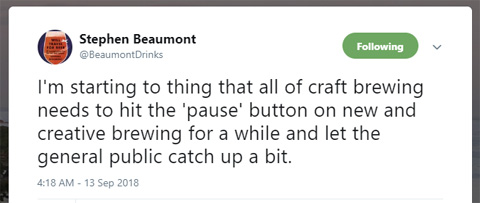
I was already thinking about the speed at which beer seems to be barreling ahead when this tweet from Stephen Beaumont showed up in my Twitter feed early (he’s in Italy) yesterday. The reason being that I’ve just finished reading Fal Allen’s Gose: Brewing a Classic German Beer For The Modern Era. Allen had never heard of the style months before Anderson Valley Brewing made its first one in July 2013. Now he’s written a book about it that fills 221 pages.
 That he knew nothing of it is a bit humbling, given that it one of the “wheat beers from the past” I wrote about in Brewing With Wheat, which was published in 2010. Later that year I provided a “how to” guide on how to brew a gose for The New Brewer, the magazine for members of the Brewers Association. The point was that gose was a oddity. Now it is everywhere and includes beers that go well beyond your basic sour German ale with a bit of salt and coriander.
That he knew nothing of it is a bit humbling, given that it one of the “wheat beers from the past” I wrote about in Brewing With Wheat, which was published in 2010. Later that year I provided a “how to” guide on how to brew a gose for The New Brewer, the magazine for members of the Brewers Association. The point was that gose was a oddity. Now it is everywhere and includes beers that go well beyond your basic sour German ale with a bit of salt and coriander.
This allows Allen to dig into the history of the beer — yes, I’m jealous — while, as the title suggests, also placing it in a modern context. Are you drinking gose, and a lot of people are, and want to know all about it? This is a book for you. Want to learn everything about how to brew it from somebody who is really good at it. Again, the book for you.
One example. Goslar, where there style originated, was once a brewing center, with 300 breweries in 1500. As Allen writes, the gose origin story “has it that the salinity of gose once came from the mineral-laden water of the Gose river.” Later, as beers from Goslar gained in popularity other brewers added salt to emulate their character.
But, here’s the thing, Allen provides a Gose river water analysis and the water doesn’t turn out to be very high in mineral content. However, he notes, there are several salt mines to the east, which made salt a much more cost effective way for brewers in Goslar to add a bit of mouthfeel to their beers. Interesting implications, although it is up to us reading to draw conclusions. Allen wisely does not suggest what there are no records to support.
The recipes, there are 27 of them, illustrate that not only has gose gone from an oddity to something you find seemingly everywhere, but many are more 21st century than 19th. My favorite remains Tiny Bubbles from Hollister Brewing in Goleta, California. It won a silver medal at the 2010 Great American Beer Festival in the German-Style Sour Ale Category and showed brewers who had a chance to try just how terrific a traditional approach could be. Others are less classic. For instance, Phil Markowski at Two Road Brewing contributes a recipe using ingredients that can be found in a supermarket, including Fleischman’s bread yeast and Fagi Greek-style plain yogurt as a souring agent.
Gose has its own category at GABF now, with two sub categories: Leipzig-style Gose and Contemporary Gose. There were 96 entires at GABF last year. The gold medal beer, Mermaid’s Scorn from Benchtop Brewing in Virginia, was made with oysters. Definitely not standard issue in northern Germany. The silver medalist was made with sea salt, the bronze medalist with passionfruit.
Contemporary appears to be winning. About a year ago in an exchange of emails about gose Allen asked about my general thoughts. I replied, “It took me a while to get past brewers making anything but something basic, like Ritterguts. I likely was in danger of being one of those ‘get off of my lawn’ guys. I thought why would anybody do anything different than Eric Rose was with Tiny Bubbles? (Then) at some point I realized that the acidity and salt do make a great base for other flavors.”
Which brings us back to the top. Gose seems to be one of those styles that brewers feel free to experiment with, and sometimes the results have been horrible. Maybe because they had a bad idea, but maybe because they screwed up the beer at the center (another discussion). I don’t think the problem is brewers running ahead of drinkers. The problem sometimes is brewers running ahead of themselves.
Disclosure: Brewers Publications, which published Gose, has also published four books I have written.
thank you Stan – Fal